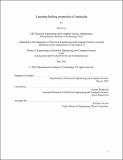Learning boiling properties of materials
Author(s)
Lu, Kerri
DownloadThesis PDF (5.758Mb)
Advisor
Broderick, Tamara
Terms of use
Metadata
Show full item recordAbstract
Boiling is an important physical process with applications to power generation, thermal management, and water treatment. In this work, we designed and implemented machine learning algorithms to predict a material surface’s boiling properties, including its critical heat flux and boiling curve. Our dataset contained over 200 sandblasted copper surfaces and corresponding boiling data collected from experiments.
Starting with high-level input features, we found that the sandblasting parameters used to manufacture the material are not predictive of boiling properties. This motivated us to investigate lower-level features: we developed and tested an algorithm to detect cavities in a surface’s height profile and extract features such as cavity depth, radius, and size. We found a direct correlation between sandblasting particle size and these cavity features, matching our intuition that larger particles result in rougher surfaces.
However, this effect does not propagate forward to the surface’s boiling properties, as the cavity features are not predictive of boiling curve coefficients. We hypothesized that this discrepancy arose because most cavities are not “active nucleation sites” where air is trapped during boiling. Building upon our cavity detection procedure, we designed an algorithm to identify active nucleation sites on a surface profile, in order to extract more fine-grained features for boiling curve prediction.
Date issued
2022-05Department
Massachusetts Institute of Technology. Department of Electrical Engineering and Computer SciencePublisher
Massachusetts Institute of Technology